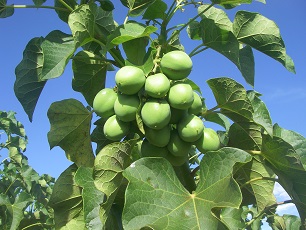Jatropha Useful Tropical Plant for Biofuel/Leaves for Fertility
Jatropha Useful Tropical Plant for Biofuel/Leaves for Fertility (Contraceptive)

Description
Oil plants called jatrophas are members of the Euphorbiaceae family. There are more than 175 species in the Jatropha genus, including Jatropha curcas L. along with Jatropha platyphylla Müll. Arg.
That has gotten a lot of interest as a possible source for animal feed and biofuel. While Jatropha platyphylla is a non-toxic species, Jatropha curcas has both toxic and non-toxic genotypes.
The Jatropha Tree Plant
Similar to the cassava plant, jatrophas are perennial shrubs or trees that can withstand drought and serve a variety of purposes.
A deciduous tree, jatropha loses its leaves in the dry season. It can reach a height of three to five meters and can produce for up to fifty years.
Jatropha has four little lateral roots in addition to a deep taproot. Both the lateral roots and the taproot stabilize the soil against landslides by anchoring the plant in the ground.
When sliced, the smooth, grey bark covering the trunk releases a watery, gooey latex. The smooth, 4-6 lobed, 10-15 cm long and wide, and often light green leaves have smooth surfaces.
The inflorescences form at the tip of the branches and contain 10 or more ovoid fruits (pods).
In places that are permanently humid, flowers and fruits can grow year-round or during the rainy season; the ripe pods, which include numerous elliptic seeds, turn yellow. 38% of the husks and 62% of the seeds make up the dry jatropha fruit. The seeds are black in color and resemble castor seeds in shape.
The majority of Jatropha species, including Jatropha curcas, have a number of poisonous elements, and if they are not detoxified, the plant and its byproducts are harmful to people and animals.
Native Americans in Mexico’s Sinaloa State consume a non-toxic species of Jatropha platyphylla and name it “sangregrado.”
The leaves of this species, which are carried on long petioles and are glabrous and bigger (25–35 cm) than those of Jatropha curcas, have thick, succulent branches.
Its almost round seeds contain between 50 and 60 percent edible oil.
Jatropha Uses
Jatropha plants provide many functions. Because of its several potential medical uses, the name jatropha was formed from the Ancient Greek words iatros (doctor) and trophos (feed).
Jatropha seed oil is used in the production of soap, lubricants, varnish, pesticides, and pharmaceuticals.
It makes a suitable feedstock for making biodiesel. Both North American (ASTM D6751) and European Union (EN14214) criteria are met by jatropha biodiesel.
- Jatropha oil cake (oil kernel meal) is produced when the oil from decorticated seeds is extracted. It can be applied as fertilizer or as a feedstock for the creation of biogas.
- Jatropha kernel meal is a product rich in protein. Still, it can only be utilized as a feed resource if it is obtained from non-toxic genotypes of Jatropha curcas, from the non-toxic species Jatropha platyphylla, or if toxic genotypes of Jatropha curcas have been detoxified.
- Jatropha seed meal is made from non-dehulled seeds that have been extracted.
- Fences and shelters made of jatropha plants can be used to ward off animals, wind, and erosion.
- The roots of the jatropha plant produce oil with anthelmintic qualities.
- Due to the antibacterial and anti-inflammatory characteristics of jatropha leaves, they are utilized as a vegetable in human nutrition and as feed for silkworms.
- Humans occasionally boil or roast whole non-toxic genotype seeds and use them as a snack.
- Jatropha latex is employed as a molluscicide and dye.
- The fruit hulls can be used to make biogas or as green manure.
Medical Benefits
It should be emphasized that all parts of the plant are extremely dangerous, so extreme caution should be used whenever using this plant for any internal use, despite the fact that it is widely utilized in traditional medicine and to some extent in modern medicine.
The conventional usage is backed by contemporary research. Latex, for instance, possesses antibacterial activity against Staphylococcus aureus, Candida albicans, Escherichia coli, Klebsiella pneumoniae, and Streptococcus pyogens.
It also causes blood plasma to coagulate.
Human lymphoblastoid cells in culture were moderately protected by a methanol extract of the leaves from the cytopathic effects of the human immunodeficiency virus.
The bark’s juice is used to treat malarial fevers and can help reduce edema brought on by inflammation.
Additionally, this juice is applied topically to treat ringworm, eczema, scabies, burns, and scabies.
To treat pyorrhoea, the fresh bark is broken up into small pieces and chewed or retained in the mouth for one to two hours.
To treat gum swellings and wounds, a bark paste is administered to the gums
In Nepal, thin twigs are frequently used as toothbrushes to relieve toothaches.
They are thought to be particularly effective for treating swollen and bleeding gums.
As a diuretic, for bathing, to treat coughs, and as an enema to treat convulsions and fits, a leaf infusion is employed.
The leaves are also used to treat guinea worm sores, fevers, rheumatic discomfort, jaundice, and poor fetal development in pregnant women.
In Ghana, ashes from burned leaves are injected into the abdomen to treat hemorrhoids.
To clean teeth, and gums, and heal ulcers on the tongue and in the mouth, the latex or juice of the leaves is directly applied to wounds and cuts as a styptic and astringent.
Also, treating decaying teeth is thought to benefit from it.
The seeds taste like groundnuts, and 15 to 20 of them will make you gag, urinate, and vomit for 30 minutes.
According to Gabonese sources, 1–2 roasted seeds are all that is needed to have a purgative effect; taking more than that could be harmful.
Castor oil has been replaced by seeds, which are also referred to as “larger castor oil.” In addition, the seeds are utilized to treat syphilis.
Curcas, the name for the seed oil, is a potent emetic and purgative.
The oil is a component of the oily extract known in Hausa as “kufi,” which is a rubefacient for rheumatism and parasite skin disorders.
It is frequently used for treating skin diseases such as herpes, itches, eczema, and boils as well as to calm pain from rheumatism.
In order to promote hair development, the oil is utilized. It is applied to the management of
It is heated and used on burns
The rise and fall of jatropha as a source of biofuel
Many developing nations promoted the growth of jatropha in the 2000s in order to produce both more money and renewable energy.
Around 900,000 acres of jatropha projects were active by the year 2010 on around 250 different continents.
Millions of small-scale farmers and landless individuals in India were urged to cultivate jatropha.
The Chinese government made the decision to plant jatropha on one million hectares of marginal land in 2006.
Jatropha plantations were started by more than 10,000 small farmers in Tanzania, and many more did the same elsewhere in East Africa.
However, the outcomes have been underwhelming. 85% of the jatropha farmers in India have stopped producing it.
Jatropha seed-based biodiesel is not widely produced in China.
The outcomes are highly disappointing in Tanzania: the net present value of a five-year investment in a jatropha plantation was negative, with a loss of US$ 65 per ha on lands with yields of 2 t/ha of seeds when the predicted jatropha seed production on poor barren soils is only 1.7 to 2.2 t/ha.
Analysts attribute the “extraordinary collapse of jatropha as a global biofuel” to an overestimation of the plant’s potential, as the species is not yet sufficiently adapted to agriculture to produce sustainably high yields and economic returns, as well as a lack of diligence in putting national cultivation plans into practice.
Distribution
Mexico is considered to be the birthplace/origin of jatropha in tropical America.
Portuguese sailors who traveled to Cape Verde and Guinea Bissau may have brought it from the Caribbean to other areas.
Due to its ability to flourish in a variety of climatic zones with a wide range of rainfall, it is now available in many deserts, semiarid, tropical, and subtropical regions of the world.
Jatropha thrives in dry and semiarid environments. It can grow on marginal fields with little water and agrochemical supplies, however, in those circumstances, it won’t produce enough seeds.
Processes
Jatropha fruits are harvested, dehusked, and the seeds are sun-dried before being shelled. When the kernels are squeezed to extract the oil, a protein-rich jatropha kernel meal is produced.
Impact on the Environment
Wind protection and soil erosion prevention
Jatrophas can contribute significantly to soil preservation in two ways their taproot and lateral roots.
Lateral roots help to provide soil cohesion and protection from flooding, which reduces soil erodibility.
Even in extremely dry situations, the deep taproot draws moisture from the subsurface soil to improve vegetative cover or for intercropping.
Rainwater infiltration is improved by planting jatropha in straight rows to create contour bunds.
Wind erosion is lessened by jatropha hedges because they slow down the wind and bind the soil with their surface lateral roots.
Health Benefits Of Jatropha (Hospital Too Far)
‘Hospital too far’ is another name for the plant Jatropha tanjorensis, which belongs to the Euphorbiaceae family;
It is typically grown in regions of West Africa’s rainforest. The therapeutic properties of jatropha are well established. The plant, known in Yoruba and Igbo as “Efo Iyana-Ipaja” and “Ugu Oyibo,” is extremely similar to tree spinach.
Another plant in the Euphorbiaceae family is Jatropha curcas, sometimes referred to as Barbados Nut or Hedge Castor Oil Plant.
The Yoruba people of Nigeria refer to it as ewe Lapalapa. It’s a plant that’s popularly used for its therapeutic properties.
It is frequently employed, especially in rural regions, in the preparation of herbs. The plant’s versatility as a herb is what makes it so amazing.
Jatropha tanjorensis is abundant in antioxidant minerals like phosphorus, selenium, zinc, vitamin C, and vitamin E, according to scientific investigations.
It has qualities that are antioxidant, anti-inflammatory, analgesic, anti-diarrheal, and anti-bacterial.
Some of Jatropha tanjorensis (hospital too far) health benefits include;
Relieves Constipation
The jatropha plant’s ability to facilitate easier digestion and pass out stool is only one of its many health advantages.
It is used as a remedy for constipation and other digestive problems because of this. The digestive process would be accelerated by chewing the leaves uncooked, making it simpler to expel waste. Another purpose for it is to treat an upset stomach.
Heals Fever
Jatropha is also used to treat fever, especially in infants and young children, which is another advantage for health.
Because they do not have to take medication orally, which most kids dislike, it is an excellent alternative to what youngsters are used to.
Simply placing some leaves on the child’s forehead will cause their fever to pass.
Cure Skin Problems
Jatropha leaves are useful for treating skin conditions as well.
This is due to the fact that they have anti-inflammatory and antibacterial qualities that make them highly efficient against a variety of skin disorders, such as eczema, acne, ringworm, phlegm, and so forth.
Crush the leaves and apply them to the damaged regions until the juice from them dries up to use the leaves.
Additionally, it is used to treat scrapes and blisters and guard against infections like ulcers.
Relieving Pain
Because jatropha leaves have analgesic effects, using them to treat pain is also beneficial.
Rheumatism, arthritis, and other pains affecting the joints and other areas of the body could all be treated with this.
The leaves must be ground and prepared for drinking like herbs in order for this to work.
For Easy Delivery
Jatropha leaves were traditionally given to pregnant women who were about to go into labor so they may ease the delivery process.
Even though there is no proof of this fact today, the practice has continued.
Favorable to Dental Health
Your dental health will benefit greatly from jatropha as well. The bark paste is used to cure gum swelling, the twigs can be used to manufacture toothbrushes that are good against toothaches, and eating the leaves also helps to treat pyorrhea.
Other Health Benefits of Hospital Too Far (Jatropha tanjorensis):
Its anti-diabetic benefits have been demonstrated in several animal studies.
- Jatropha tanjorensis was found to have antibacterial and antioxidant qualities, according to a medical investigation.
Questions People also ask
What is Jatropha used for?
It treats rheumatism, sores, and skin conditions in domesticated livestock.
Cleaning is done with the Jatropha plant’s delicate wing. To treat piles externally, the leaf’s juice is used. The roots are thought to treat snake bites.
What is the Jatropha leaf in Yoruba?
Don’t be misled; although the jatropha plant is a Yoruba plant known as “Lapalapa,” the one we are cultivating is a hybrid that has the required amount of oil.
The maturation process takes nine months.
What is the Yoruba name for Jatropha curcas?
In Nigeria, the Igbo name it Olulu idu, Owulu idu, the Yoruba call it Botuje, and the Hausa call it Bini da Zugu. It is a plant with decorative, therapeutic, and many uses.
What are the benefits of Jatropha in medicine?
The benefits of Jatropha gossipifolia (Euphorbiaceae) for biological research, traditional medicine, and other purposes are discussed in this paper.
It had strong antibacterial, anti-inflammatory, analgesic, antioxidant, anti-diarrheal, and anti-fertility properties.
Family planning has historically been accomplished using Jatropha gossypifolia.
Can Jatropha seeds prevent pregnancy? How can I use Jatropha seeds as a contraceptive?
Jatropha variegata, a member of the Euphorbiaceae family, is a native to Yemen and is referred to as the Ebki shrub there. Local women traditionally consume the plant’s fruits as a natural form of birth control.
What advantages does jatropha have in terms of medicine?
The benefits of Jatropha gossipifolia (Euphorbiaceae) for biological research, traditional medicine, and other purposes are discussed in this paper.
It had strong antibacterial, anti-inflammatory, analgesic, antioxidant, anti-diarrheal, and anti-fertility properties. Family planning has historically been accomplished using Jatropha gossypifolia.
Can jatropha prevent getting pregnant? What are Jatropha’s side effects?
Despite the fact that the plant’s entire body is poisonous, the seeds are particularly lethal due to their high ricin content.
When seeds are consumed, negative side effects can include nausea, diarrhea, abdominal pain, and a burning sensation in the throat.
Is jatropha a stomach ulcer remedy?
Folk medicine uses the roots of the Euphorbiaceae plant Jatropha elliptical (Pohl) Oken to treat gastric ulcers.
What are the advantages and disadvantages of Jatropha?
Since jatropha can grow in many types of soil and climates, it is grown in the majority of locations. The fact that jatropha is poisonous to cattle is a significant disadvantage.
What cosmetic purposes does jatropha oil serve on the skin?
A number of beauty and personal care products use the adaptable ingredient jatropha oil.
It is frequently found in hair care products like shampoos and conditioners as well as skin care items like moisturizers and serums.
Additionally, it serves as a vehicle for essential oils.
Which country is the largest producer of Jatropha?
Indonesia will be the biggest producer in Asia. The biggest producers in Africa will be Ghana and Madagascar, while Brazil will lead Latin America.
Why did Jatropha fail?
Poor yields, land grabbing, deforestation, and societal issues in the nations where jatropha was grown, including Ghana, where jOil operates, hindered jatropha plantations during the initial boom.
What products can you get from Jatropha?
Glycerol, which is used to make propylene glycol, is another significant byproduct of the jatropha plant.
Unsaturated polyester resins, polyether polyols, functional fluids, cosmetics, and flavoring for toiletries are all made with propylene glycol.
Castor and Jatropha the same? What is Jatropha oil’s alternate name? Can you find jatropha in Nigeria?
Nigerians refer to the jatropha plant by a variety of names, including botuje pupa, lapalapa pupa, okpokporu, and sherigun. After palm oil, the jatropha plant has been recognized as a crucial source of biofuels.
Where can one find jatropha in Nigeria?
In dry and semi-arid areas of Nigeria and Africa, jatropha is a drought-resistant plant that thrives.


